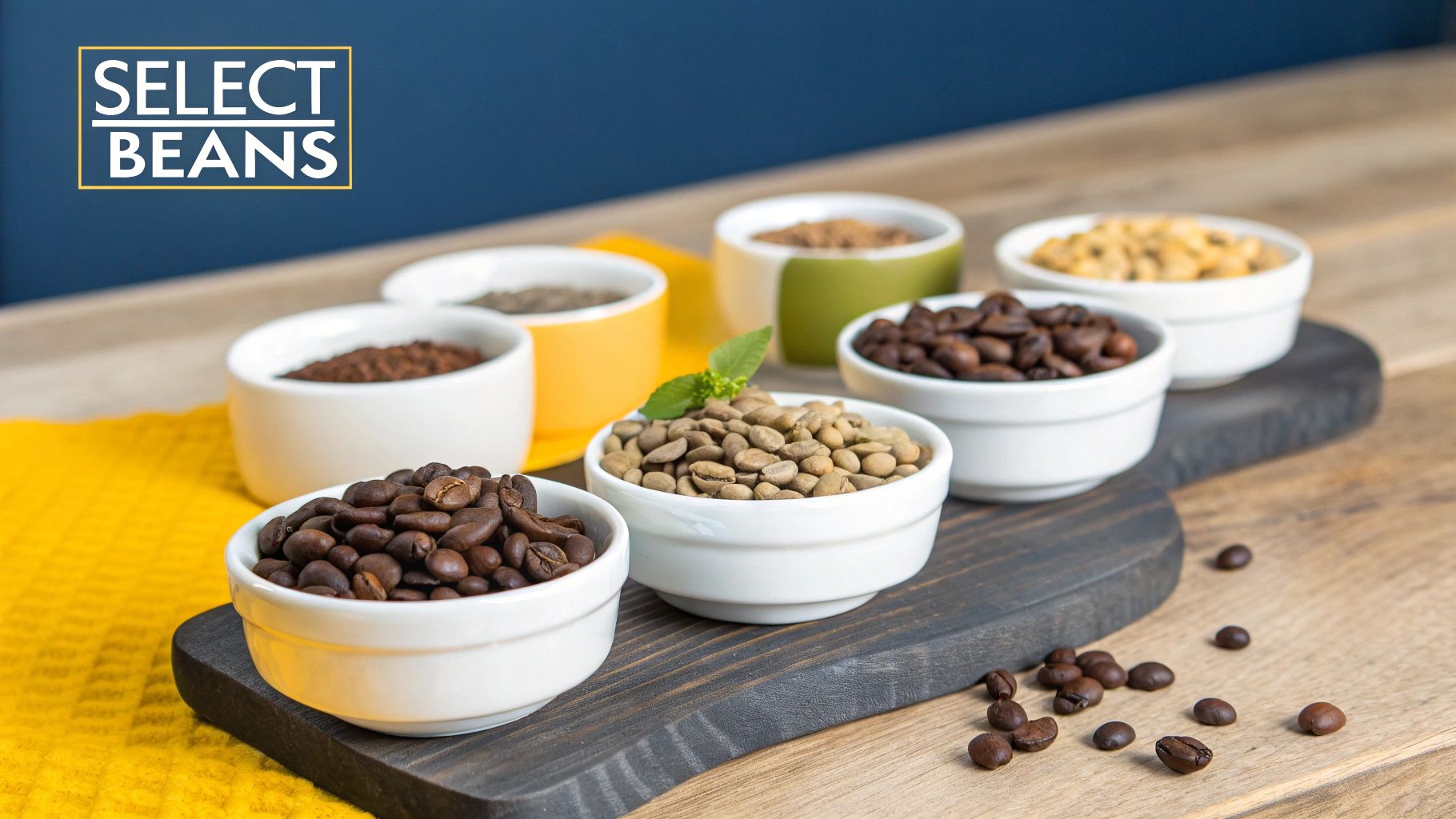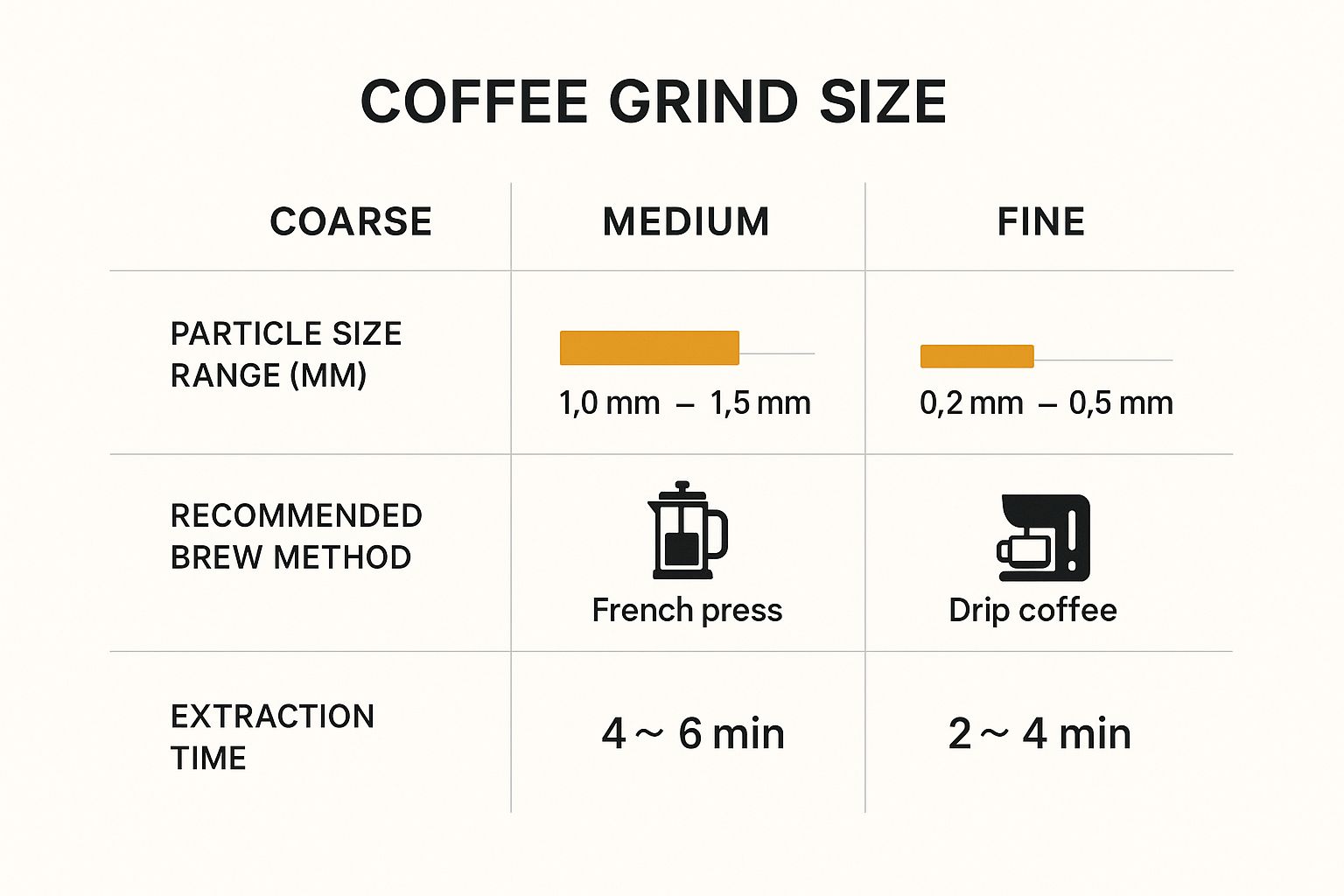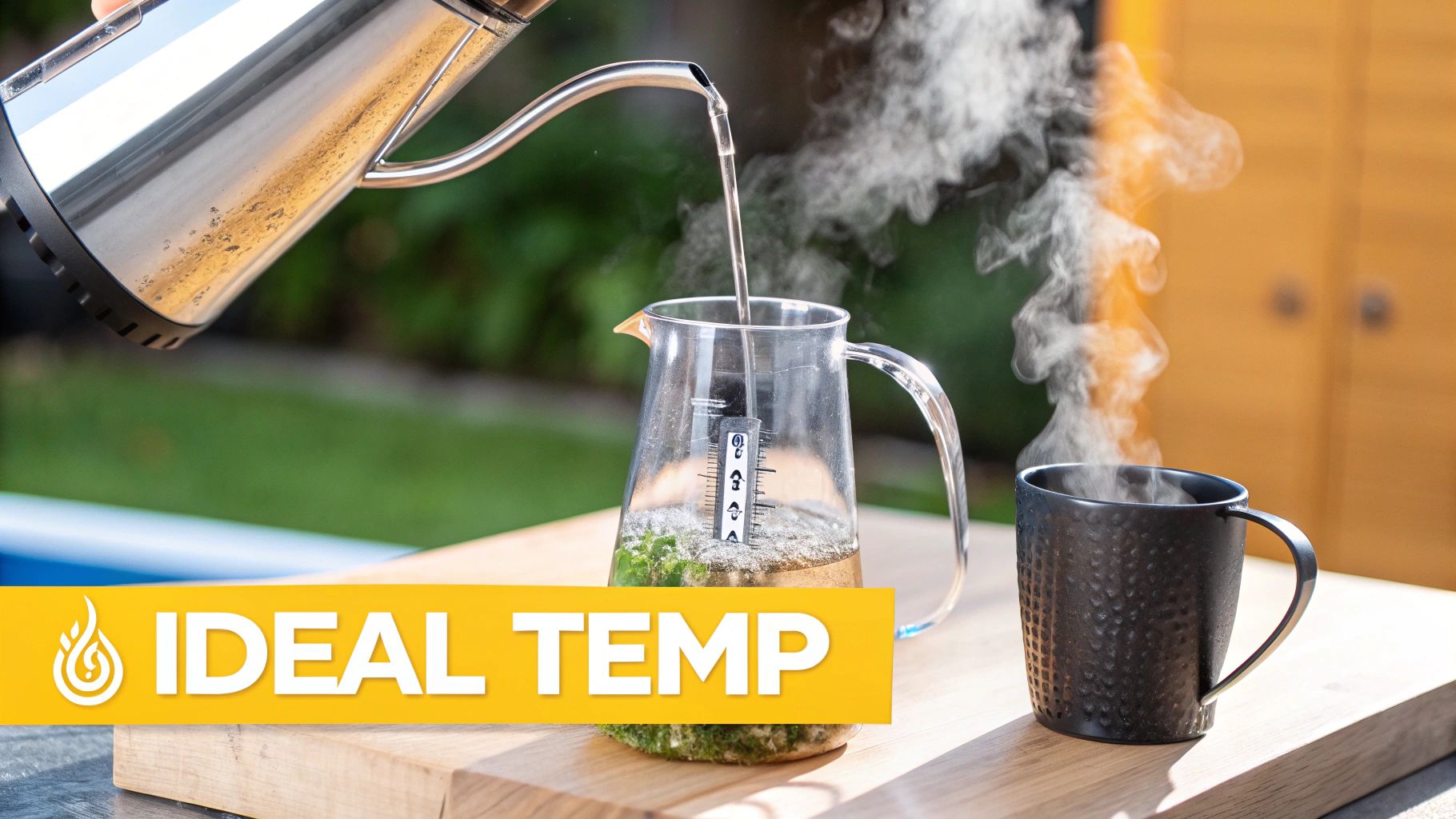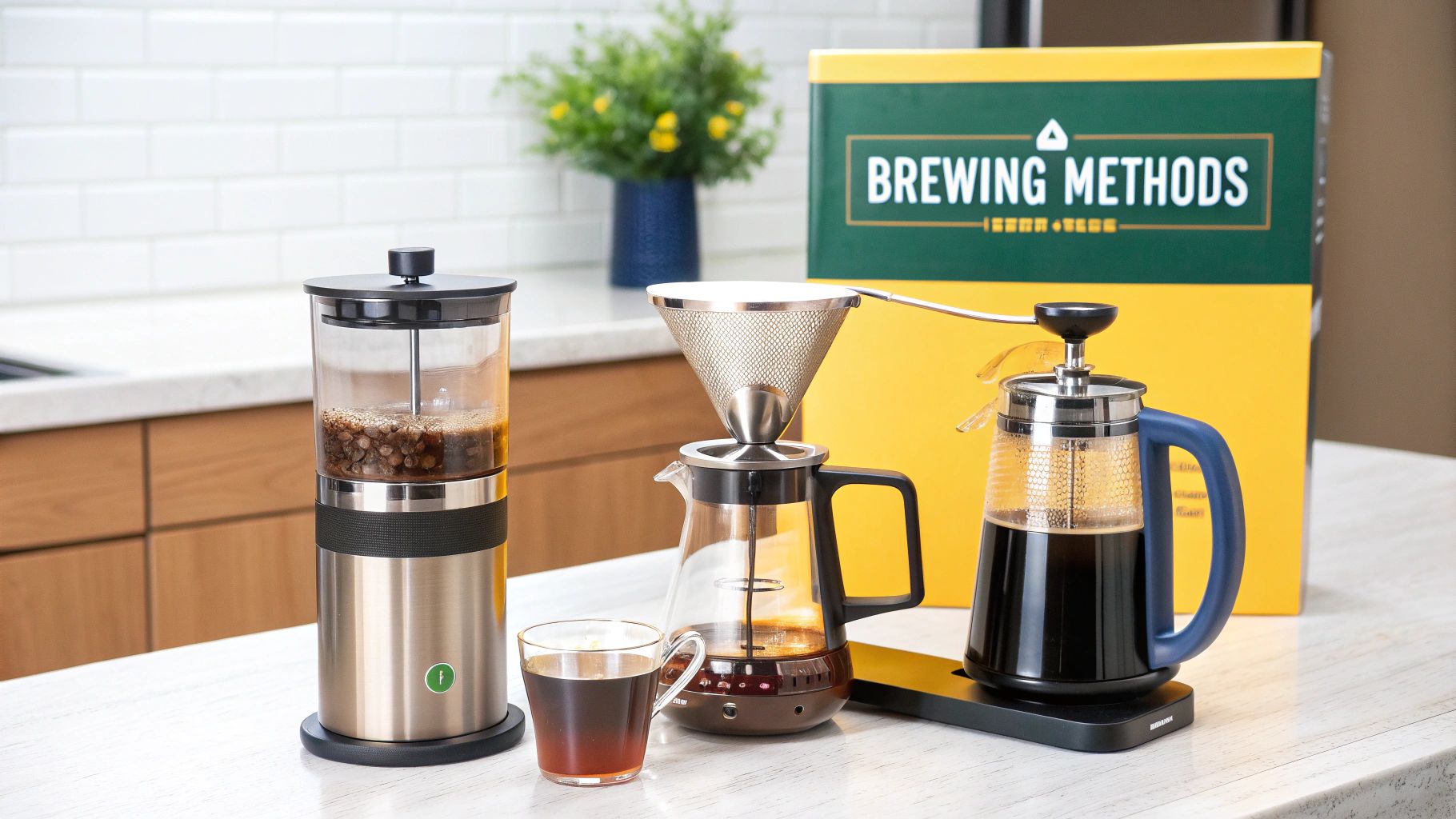It's a common misconception that you need a counter full of expensive gear to make great coffee at home. The truth is, it's surprisingly personal, but it always boils down to mastering four key things: high-quality beans, a consistent grind, the right water temperature, and the perfect coffee-to-water ratio.
Get those right, and you're golden.
Your Journey to Perfect Home Coffee Starts Now
Welcome. This is your definitive guide to making truly exceptional coffee right in your own kitchen. We’re going to skip the generic advice and get straight to the practical skills that actually make a difference. A fantastic cup isn't about the fanciest machine—it’s about understanding and controlling the variables that shape the flavor in your mug.
This shift from a quick caffeine fix to a thoughtful ritual is happening everywhere. Brewing coffee at home has gone from a mundane routine to a celebrated moment for so many of us. People are actively hunting for better beans and dialing in their methods to make their daily cup something special.
The Rise of Specialty Coffee at Home
One of the biggest signs of this change is the incredible boom in specialty coffee. This isn't just a niche hobby for coffee snobs anymore; it's a full-blown movement.
The search for a better cup has sparked a massive wave of home-brewing enthusiasm. People are discovering that with a bit of know-how, they can easily match—and often beat—the quality of their favorite café.
This isn't just a feeling; the numbers back it up. A recent report showed that specialty coffee consumption in the U.S. just hit a 14-year high. A whopping 64% of 25–39 year-olds said they drank specialty coffee in the last week, which is the highest of any age group. If you're curious, you can explore the full findings on specialty coffee trends and see just how much home brewing has taken off.
This guide is designed to give you the essential techniques to be part of this movement. We're going to demystify the core components of a great brew:
- Bean Selection: What "freshness" really means and how roast profiles affect taste.
- Grind Consistency: Why this is hands-down the most important upgrade you can make.
- Water Quality and Temp: The unsung hero of amazing coffee.
- Brewing Ratios: The secret to getting balanced, delicious results every single time.
Whether you're just starting to dip your toes into the world of good coffee or you're looking to perfect your technique, you're in exactly the right place. Let’s brew something amazing together.
Mastering the Four Pillars of Great Coffee

Before we even get into brewers and fancy gadgets, let's lock in the four fundamentals that truly separate a mediocre cup from a memorable one. Honestly, mastering these is the absolute best way to prepare coffee at home, no matter what equipment you're using. Think of them as your non-negotiables for incredible flavor.
The Beans: Freshness Is Everything
First things first, let's talk about the star of the show: the coffee beans. The single most important factor here is freshness, bar none. Coffee is a perishable product, and its most vibrant, exciting flavors start to fade just a few weeks after it's been roasted.
You can forget the "best by" date you see on big supermarket bags. You should be looking for one thing and one thing only: a "roasted on" date. This little detail tells you exactly when the beans were at their peak. For the best possible experience, you’ll want to brew your beans within one to four weeks of that date.
Buying from a roaster like Cartograph Coffee ensures you're getting beans at their absolute peak of flavor. This one simple choice elevates your home coffee game more than any expensive machine ever could.
The Grind: Consistency Is King
If you're going to make just one upgrade to your coffee setup, make it a quality burr grinder. Why? Because when it comes to grinding, consistency is king. Pre-ground coffee goes stale incredibly fast as oxygen gets to work, stripping away all those delicate aromas and flavors. Grinding right before you brew keeps them locked in until the last second.
A burr grinder works by crushing beans between two revolving surfaces, creating uniform-sized particles. This is key for an even, balanced extraction. Blade grinders, on the other hand, just smash and shatter the beans into a chaotic mix of fine dust and large chunks. This inconsistency leads to a brew that’s somehow both sour (from the under-extracted big pieces) and bitter (from the over-extracted dust).
The Water: Purity and Temperature
It might sound obvious, but coffee is 98% water. That means the quality of your H2O has a massive impact on the final taste. If your tap water has a strong taste of chlorine or heavy minerals, guess what? Those flavors are going to end up right in your cup. Using simple filtered water is an easy fix that results in a much cleaner, sweeter brew.
Temperature is just as critical.
- Water that’s too cool won't extract enough flavor, leaving your coffee tasting weak, thin, and sour.
- Water that’s too hot will literally scald the grounds, pulling out harsh, bitter notes.
The sweet spot for pretty much all brewing methods is somewhere between 195-205°F (90-96°C). You don't need a high-tech kettle to get there, either. A simple trick is to bring your water to a full boil, then just take it off the heat and let it sit for about 30-45 seconds before you start pouring. That brief pause is usually enough to land you right in the ideal temperature window.
The Ratio: Precision Creates Predictability
Finally, let's demystify the whole coffee-to-water ratio thing. This is just the measurement of how much ground coffee you use for a specific amount of water. Just "winging it" is a recipe for disappointment—one day your coffee is like rocket fuel, and the next it’s thin and watery.
A fantastic starting point that works for most brewers is what's often called the "Golden Ratio," which is generally 1 part coffee to 15-18 parts water. A 1:16 ratio is a common and delicious sweet spot. For example:
- 20 grams of coffee to 320 grams of water (makes a perfect single large mug)
- 60 grams of coffee to 1000 grams of water (for a full pot to share)
Using a simple kitchen scale to weigh both your beans and your water takes all the guesswork out of the equation. It’s the real secret to brewing a consistently delicious cup, every single time. Once you nail these four pillars, you've officially mastered the fundamentals of great coffee.
Choosing Your Ideal Home Brewing Method
Now that you have a solid feel for coffee’s core principles, you’re ready to find the brewing device that fits your life. The best way to brew coffee at home isn’t about chasing some single “correct” method; it’s about matching a brewer’s strengths to your taste and your daily routine. Let’s walk through the most popular options, not just as a list, but by the experience and flavor each one delivers.
This personal approach is part of a much larger shift. The at-home coffee market is absolutely booming, expected to hit US$96.45 billion by 2025. This isn't just a number; it reflects a culture that values both convenience and quality, with more and more people making coffee a core part of their lifestyle.
The Pour-Over For The Flavor Chaser
A pour-over, using a device like a Hario V60 or Kalita Wave, is for the person who loves the process as much as the result. It gives you incredible control over every variable—from water flow to extraction time—letting you highlight the subtle, nuanced flavors in a high-quality single-origin bean.
The result is a cup that’s incredibly clean, bright, and often tea-like in its clarity. It's the perfect method for tasting the delicate floral or fruity notes of a Cartograph Coffee light roast.
- Best For: The coffee enthusiast who enjoys a mindful, hands-on morning ritual and wants to explore the full spectrum of coffee flavors.
- Effort Level: High. It demands your full attention, a gooseneck kettle for precision, and a bit of practice to really nail your technique.
The French Press For The Bold And Full-Bodied
The French Press is a classic for a reason. Its immersion brewing style, where coffee grounds steep directly in the water, produces a rich, full-bodied cup with a satisfyingly heavy mouthfeel. Because it uses a metal mesh filter instead of paper, more of the coffee's natural oils make their way into your mug, which is what gives it that robust character.
This method is wonderfully forgiving and just plain simple. If you love a dark, strong, and deeply satisfying brew that stands up well to a splash of milk, the French Press is your perfect companion.
The choice between a paper filter (pour-over) and a metal filter (French press) is one of the biggest factors determining your coffee's final texture and clarity. One isn't better than the other—it's purely a matter of personal preference.
The infographic below shows how your grind size—coarse for a French Press, medium for drip, and fine for espresso—directly impacts how you should brew.

As you can see, coarser grinds need longer contact time with water to extract all that flavor properly, which is exactly why immersion methods like the French Press work so well.
The AeroPress For The Versatile Adventurer
The AeroPress is the coffee world's Swiss Army knife. It's fast, incredibly durable, and just about as versatile as it gets. Using air pressure to push water through the grounds, it can make everything from a clean, pour-over style cup to a concentrated, espresso-like shot in about a minute.
Its speed and portability make it a favorite for travelers, campers, and anyone with a packed schedule. Plus, the cleanup is famously easy. If you value flexibility and love to experiment, the AeroPress lets you play with countless recipes and brewing styles. It’s also important to note this is a true brewing method, unlike instant coffee, which requires no brewing at all. If you're curious about the specifics, you can explore the difference between ground coffee and instant in our detailed guide.
The Drip Coffee Maker For Effortless Convenience
Let's be clear: modern drip coffee makers have come a long, long way. A high-quality, SCA-certified machine can deliver a consistently great pot of coffee with the simple push of a button. These brewers are engineered to heat water to the optimal temperature and disperse it evenly over the grounds, basically automating the principles of a good brew.
This is the ultimate choice for busy mornings, brewing for a crowd, or anyone who just wants a delicious, no-fuss cup waiting for them. It offers reliability and convenience without a significant sacrifice in quality.
Home Brewing Method Comparison
Feeling a little overwhelmed by the options? It’s completely understandable. To make it easier, we’ve put together a quick comparison to help you see how these popular methods stack up against each other. Think about what you value most—flavor, speed, or simplicity—and find your perfect match.
| Brew Method | Flavor Profile | Ease of Use | Brew Time | Best For |
|---|---|---|---|---|
| Pour-Over | Clean, bright, clear, highlights nuanced notes | Difficult | 3-4 minutes | The detail-oriented flavor enthusiast |
| French Press | Full-bodied, rich, robust, heavy mouthfeel | Easy | 4-5 minutes | Lovers of bold, strong coffee |
| AeroPress | Versatile (clean to espresso-like), smooth | Moderate | 1-2 minutes | Travelers, experimenters, and the time-crunched |
| Drip Coffee Maker | Balanced, consistent, classic | Very Easy | 5-10 minutes | Busy households and those who value convenience |
Ultimately, the best brewing method is the one you’ll actually enjoy using day in and day out. Whether it’s the mindful ritual of a pour-over or the set-it-and-forget-it ease of a drip machine, the goal is the same: a delicious cup of coffee that starts your day off right.
Your Guide to a Flawless Pour-Over Brew

If you really want to see the core principles of great coffee in action, the pour-over is where it's at. This method is the perfect hands-on example because it puts you in the driver's seat, showing you exactly how tiny tweaks can totally change the final taste. For anyone who loves a clean, vibrant cup at home, this is the way to go.
Don't worry, we're not about to hit you with a massive shopping list. The goal is to focus on what actually makes a difference. You’ll just need a pour-over dripper (like a Hario V60), a filter, a scale, a timer, and—if you can swing it—a gooseneck kettle for that extra bit of pouring precision.
Setting Up for Success
Before you even think about brewing, a couple of quick prep steps will set you up for a much better cup.
First, pop your paper filter into the dripper and give it a good rinse with hot water. This isn't just for show; it does two critical things. It washes away any papery taste from the filter and, just as importantly, it preheats your dripper and mug. A warm setup helps keep the brewing temperature stable from start to finish.
Once you’ve rinsed, just dump the water from your mug. Now it’s time for the coffee. Add your medium-fine ground coffee—the consistency should feel a lot like table salt—into the filter. Give the dripper a gentle shake to level out the grounds. A flat bed is key to making sure water passes through all the coffee evenly, which is what gives you a balanced extraction.
The Art of the Bloom and Pour
This is where the real magic happens.
Put your whole setup on the scale and hit the tare button so it reads zero. Start your timer and begin pouring just enough hot water to wet all the grounds. A good rule of thumb is about twice the weight of your coffee. So, if you're working with 20 grams of coffee, you'll want to pour about 40 grams of water.
Almost immediately, you'll see the coffee bed swell up and bubble. This is called the bloom, and it's the coffee releasing trapped CO2. Let it sit for 30-45 seconds. This step is crucial because it allows the water to properly saturate the coffee particles for a much more even extraction.
A proper bloom is the first step toward unlocking the nuanced flavors of your beans. Skipping it can lead to a sour, under-extracted taste, as the escaping gas repels water from the grounds.
After the bloom has settled, it's time to continue your pour. Go in slow, steady circles, starting in the center and spiraling outward. Try your best to avoid pouring directly down the sides of the filter; you want the water to do its work in the coffee bed itself.
Your goal should be to have all your water poured by the 2:30 mark. The entire process, from first pour to final drip, should take somewhere between 3 to 4 minutes.
Troubleshooting Your Brew
The best tool you have for getting this right is your own palate. A quick taste of your finished coffee will tell you exactly what you need to fix.
- Tasting a little sour or thin? That's a classic sign of under-extraction. It usually means your grind is too coarse or the brew was too fast. Try grinding a little finer next time.
- Getting a bitter or harsh flavor? You've likely over-extracted the coffee. This happens when the grind is too fine or the brew just took too long. Go for a slightly coarser grind to solve it.
By paying attention to these simple cues, you'll be able to dial in your technique in no time. This hands-on process takes the mystery out of brewing and will have you making a consistently delicious, café-quality cup in your own kitchen.
Elevating Your Daily Coffee Ritual

Once you've locked in the fundamentals, you’re ready to go beyond just brewing coffee and start crafting a true coffee experience. This is where a simple drink transforms into a delightful daily ritual. It all starts by looking past the supermarket aisle.
Sourcing your beans from a local or specialty roaster is a total game-changer. These folks treat coffee like an artisanal product, carefully selecting beans and roasting them in small batches to bring out their unique character. This single shift unlocks a whole spectrum of flavors—from bright citrus to deep chocolate—that you just won't find in mass-produced bags.
Discovering the World of Coffee Origins
A huge part of this journey is getting to know coffee origins. The idea is simple: where a coffee bean is grown has a massive impact on how it tastes. This concept, known as terroir, is the same principle that gives wines from different regions their distinct personalities.
For example, beans from Ethiopia are often known for their bright, floral, and almost tea-like qualities, with notes of blueberry or bergamot. A coffee from Colombia, on the other hand, might offer a more balanced, nutty, and chocolatey profile with a rich, satisfying body. Exploring different origins is like taking a flavor tour around the world, all from your kitchen.
Venturing into single-origin coffees from small roasters is the single best way to prepare coffee at home that truly tells a story. Each bag offers a unique snapshot of a specific place, climate, and farming community.
Technological advancements are making this exploration even more exciting. Data-driven and AI-enhanced agricultural practices are leading to higher-quality coffee cherries, which in turn allows roasters to bring out even more diverse and incredible flavors for home brewers to enjoy. This synergy between better farming and brewing tech is reshaping what's possible in a home cup. You can explore more insights about how AI is improving coffee agriculture on USDA.gov.
Perfecting Your Finishing Touches
Elevating your ritual also means mastering those final steps. Storing your beans properly is non-negotiable; keep them in an airtight, opaque container at room temperature. You have to protect them from their four biggest enemies: oxygen, light, heat, and moisture.
And for anyone who loves a good latte or cappuccino, learning to froth milk is such a rewarding skill. Whether you're using dairy milk or a plant-based alternative like oat milk, the goal is to create a smooth, velvety microfoam—not just a pile of stiff bubbles.
Start with cold milk and use a frothing wand or even a French press, plunging rapidly until the volume doubles and the texture is silky smooth. This final touch is what turns a good coffee into a great one. While this skill takes practice, remember that even imperfect latte art can't ruin a well-brewed cup. That’s not always the case with other brewing methods, where common mistakes can spoil even high-quality instant coffee. For more tips on that, check out our guide on how to make instant coffee taste better.
Common Home Brewing Questions Answered
Even with the best beans and a solid recipe, questions always pop up when you're dialing in your home brewing. It’s part of the fun. Here, we'll tackle some of the most common hurdles we hear about from fellow coffee lovers. Getting these little details right is often that last step toward mastering your morning cup.
If there's one piece of gear that will change your coffee game more than any other, it's a quality burr grinder. I really can't overstate this.
Pre-ground coffee goes stale incredibly fast because all those amazing aromatic compounds are exposed to oxygen. Grinding your beans just moments before you brew is the single best way to preserve their intended flavor. A burr grinder gives you a consistent particle size, which is critical for a balanced, even extraction.
Why Does My Coffee Taste Bitter or Sour?
This is the number one question we get, and it's almost always an extraction issue. Think of it as your coffee giving you direct feedback on your technique.
-
Bitterness is a classic sign of over-extraction. You've pulled too much from the coffee grounds, including the less desirable compounds. This usually happens when your grind is too fine, your water is too hot, or you let it brew for too long.
-
Sourness points to the opposite problem: under-extraction. The water didn't have enough time or the right conditions to pull out the sweet, balanced flavors. The fix is usually a finer grind, bumping your water temp into that sweet spot of 195-205°F, or extending the brew time just a bit.
This is exactly why a simple kitchen scale and a timer are your best friends. They remove the guesswork and give you the data you need to make small, informed tweaks.
Understanding the difference between over- and under-extraction is the key to troubleshooting. Once you can identify that sharp, sour tang or that harsh, bitter bite, you have a clear roadmap to a perfect cup.
Another thing we get asked a lot is whether specialized gear is really necessary. For instance, do you actually need one of those gooseneck kettles? For a method like a pour-over, it absolutely makes a world of difference. A gooseneck gives you pinpoint control over where and how quickly you pour the water, which is critical for evenly saturating the coffee bed.
Finally, let's talk about storage. Your coffee's biggest enemies are oxygen, light, heat, and moisture. Always store your whole beans in an opaque, airtight container at room temperature. Please, don't put them in the freezer! The best strategy is simply buying smaller bags of fresh coffee more often.
If you're looking for a shelf-stable option for travel or those mornings when you just don't have the time, you might be interested in learning what coffee concentrate is and how it can be a great addition to your routine.
Ready to brew your best cup yet? Explore the exceptional single-origin and blended coffees from Cartograph Coffee and taste the difference that fresh, high-quality beans make. Shop our collection today.